#Gullah Geechee festival
Explore tagged Tumblr posts
Text
Tragic Ferry Dock Collapse on Sapelo Island Claims Seven Lives
Tragic Accident at Georgia Island Ferry Dock On Saturday, a devastating incident occurred at a ferry dock on Sapelo Island, Georgia, resulting in the loss of seven lives. This unfortunate event took place during a festival dedicated to celebrating the rich heritage of the Gullah Geechee community, which comprises descendants of formerly enslaved individuals from the Southeastern United…
#ferry dock accident#gangway collapse#Georgia news#Gullah Geechee festival#heritage celebration#rescue efforts#Sapelo Island#tragic incident
0 notes
Text
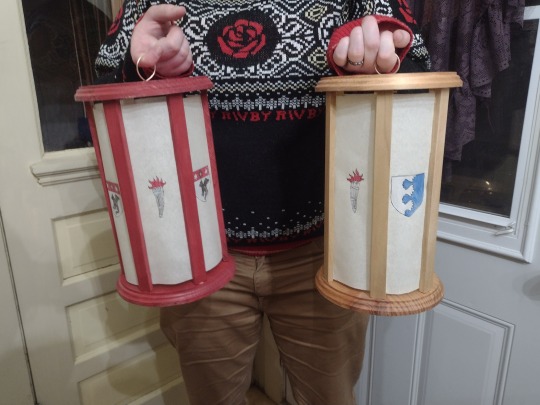
Finished product first, held by my wonderful spouse. Northshield is a kingdom big on the power of light. Our motto includes illumination as a virtue. We have a star named Griffin's Light. On top of the society A&S badge being a candle, our A&S awards are the Black Flame and Brigit's Flame. Since about year two of my tenure in the SCA I've dreamed of making a lantern scroll to honor that aspect and now I've done two. I'm so grateful to be surrounded by people who inspire me to push my boundaries and make cool art.
As such, these are lantern scrolls for Brigit's Flame awards, the GOA level Northshield arts and science award. One is for my wonderful friend Thegn Samson Muskovich (aka Samii), who does so much for the arts and sciences of the SCA. From metalworking with bronze and silver, to leatherwork and armoring, to teaching about existing as a trans person in the SCA and deep diving into the experience of the Gullah Geechee and making sure we know that the experience of Africans trafficked to America is as period as their resilience and resistance. I'm so proud that he's my cousin in the Choctaw tribe. The second is for the magnificent Dame Katerinka Lvovicha (aka Kat), who received her Brigit's Flame in 2015 but never got the scroll for it. She also does so much for Northshield, especially in the realms of heraldry and scribal arts, and she blasts a path for all Northshielders to feel safe by being extremely proactive about pronouns, cultural touchstones, and literally offering housing and travel assistance to people.
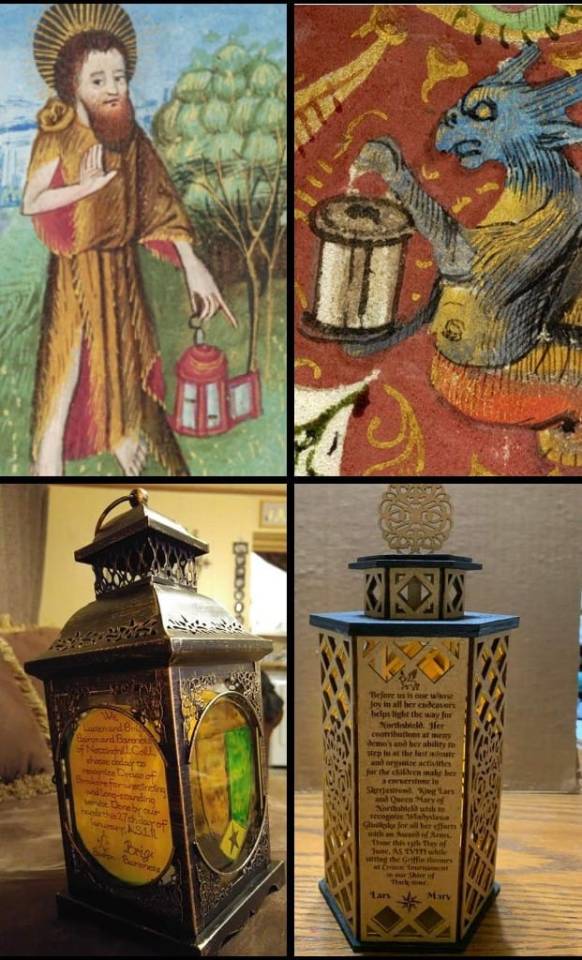
The inspirations for the project include these four lanterns and Morgan Donner's lantern build video. In the top row are two illustrations from period showing lanterns. The red lantern is from Book of Hours, MS M.972 fol. 1r, and has a bit of a splayed shape with a wider base and a turned dome at the top. It also has horn panels that aren't quite perfect fits for each side panel, as evidenced by the uneven horizontal lines. The second lantern, held by a crotchety dragonesque beast, is from Breviary, MS M. 8 fol. 158r and has a flat top with straight sides.
The second row shows two lantern awards made by other SCAdians. The first was made by Brig Ingen Erennaigh for a baronial service award called the Coill's Beacon, and the second is an Award of Arms by Northshield's own Tatiana Melville.
My original plan was actually to make a couple of so-called Viking lanterns like the kind you see all over Etsy. These usually consist of a top and bottom disc of wood, with dowels in between, and parchment or rawhide wrapped around the exterior. Extremely simple, and the parchment provides the perfect scroll text surface, but thanks to Morgan Donner's video, I now know those are dated to the 1800s. The idea of illuminated parchment stuck with me though and I decided to make a lantern more along the lines of the Breviary lantern but with simulated parchment in place of horn panes. I felt this was a good compromise between my original plan and a documentably period shape.
I didn't leave myself enough time to make this scroll, between the shield I made for Crown Tournament and Halloween festivities. Thinking fast, I ran out to my local hardware store for some precut 6 inch rounds. The ones I got have an ahistoric Roman ogee routed into the edge, but they'll add some nice visual detail to the scrolls.

Splitting my poplar side beams to width was vaguely harrowing on my radial arm saw. It would've been better to use my bandsaw but it's really not set up for use yet, so I made a janky jig and stood off to the side.

I was successful, and began the annoying process of carving 24 dowel tips.
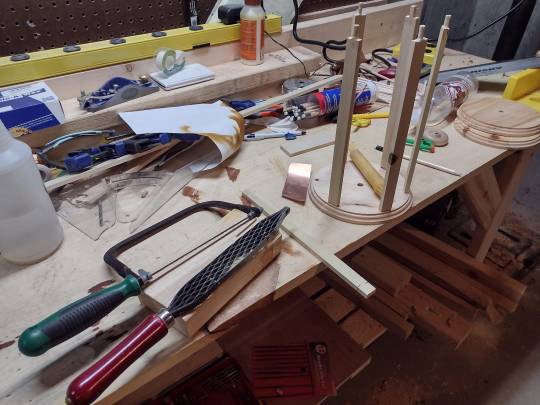
Tools of the trade, and five doweled supports installed in the first base.
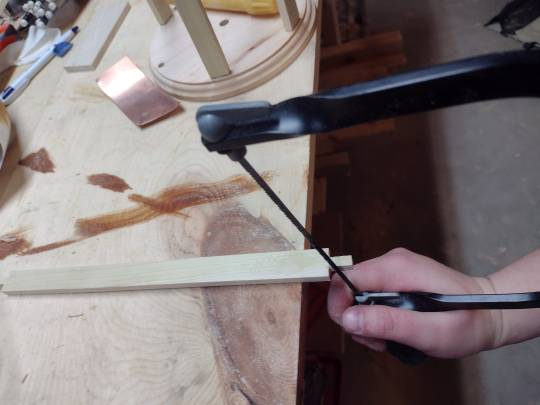
The coping saw did a great job of parting off each dowel end.
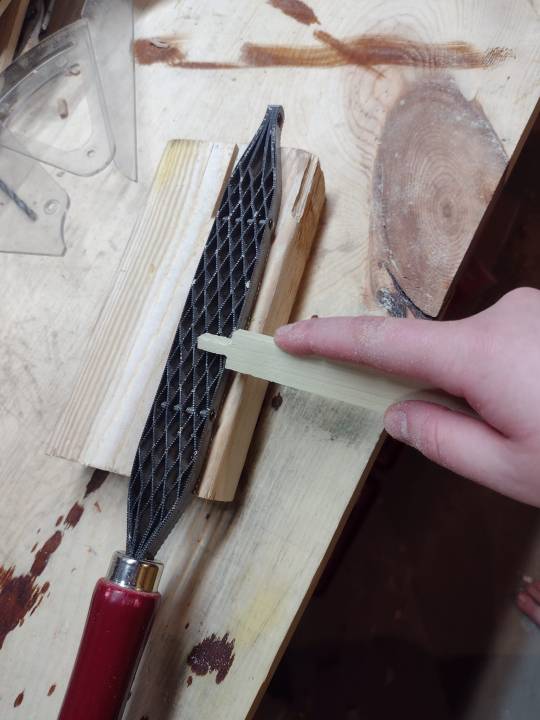
Dog bless the Shinso rasp. This thing makes my woodworking experience so much easier.

I got one set done and checked my progress. This looks really, really good so far.
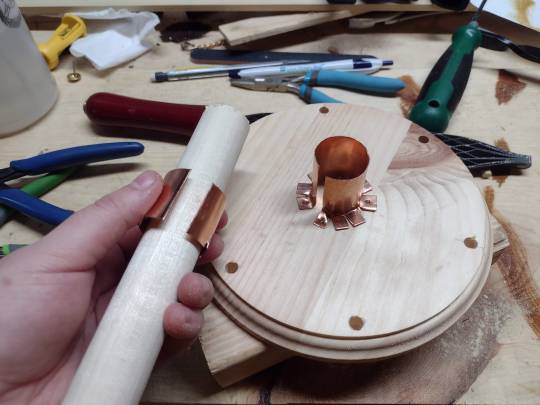
I then grabbed some copper and went to town making the candle holders. I wanted these to have some give for different diameters of candles, including electric candles. These were made entirely off of Morgan Donner's video and aren't based on anything I personally researched, so I can't say anything to their historocity beyond knowing that sheet copper definitely wasn't the material of choice back then. I used a spare fat poplar dowel to form both holders.

I then used sidecutters to make the flanges, and bent them out flat. I used some brass brads to nail the holders to the bases, and pressed them through with my drill press just as I did with the tacks to the targe I made last month.

At this stage I needed to do a test fit, and boy was I happy with the way it looked so far. Now, I must say that this is not enough spacing between the candle and the lantern roof. It'll probably be alright, but it could also get pretty dang hot and risk a fire in there. A shorter candle would be better, but I have a hundred of these beeswax candles so I'm gonna give them away as gifts whenever I can.
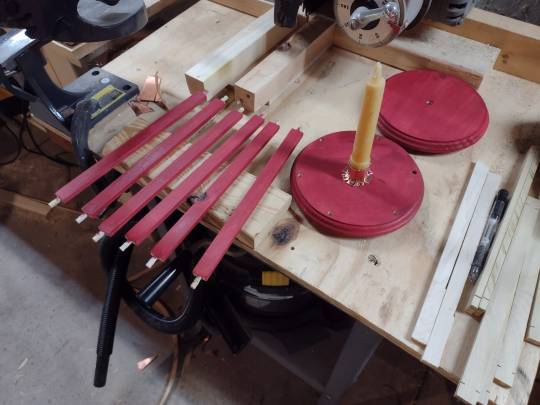
Since the Book of Hours lantern is red and Samii's livery colors are red and gold, I painted his lantern red. I used a few different paints mixed together to achieve this shade, and then I sprayed the whole thing with matte polyurethane sealant.

I decided to make Kat's a nice golden oak color in contrast to the red lantern, based on so many being light colored in the various illustrations and illuminations I saw. It was down between this and painting it blue to match her arms, but I think I'm glad I did two very different finishes. The poplar is so green that the oak stain couldn't really compensate, but it's not bad. This lantern was sealed with finishing wax.
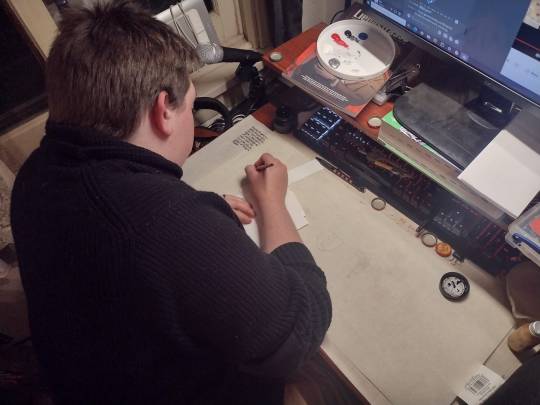
At this point Kim stepped in to get the scrolls done. This is Pergamenata, a perennial favorite of SCA scribes for having a similar surface feel and translucency to animal parchment. Usually I do illumination and word smithing while they just do the hand writing, but this time they took on all three of those tasks, much to my joy.

Here's Kat's scroll panes before color. You can see Kim used a template made off my test fit of the lantern to get the spacing correct. They used Speedball india ink and matched the hand to the calligraphy in CNM XXIII.C.124 Velislavova Bible, which they also took the design of the torch from.

Both scroll panes inked, painted and drying. We chose these scrolls to try tempera paint for the first time and the translucency of the tempera on the translucency of the perg is just so good.

Here's Kat's scroll panels with the oak-stained side supports.

Here's Samii's scroll panels with the red side supports.

The final assembly process. I had to cut the scroll panels into individual panes, because the spacing wasn't perfect. I used wood glue to affix the perg panes to the backside of each support, holding or clamping alternately to keep everything in place as the glue-wet perg curled away from the supports and then uncurled as the adhesive cured. It was a pain in the ass but it worked out. I then had to form two bronze rings for the tops of each lantern, and install hooks and loops to close the back pane, which has one end loose and wrapped around a thin piece of basswood.

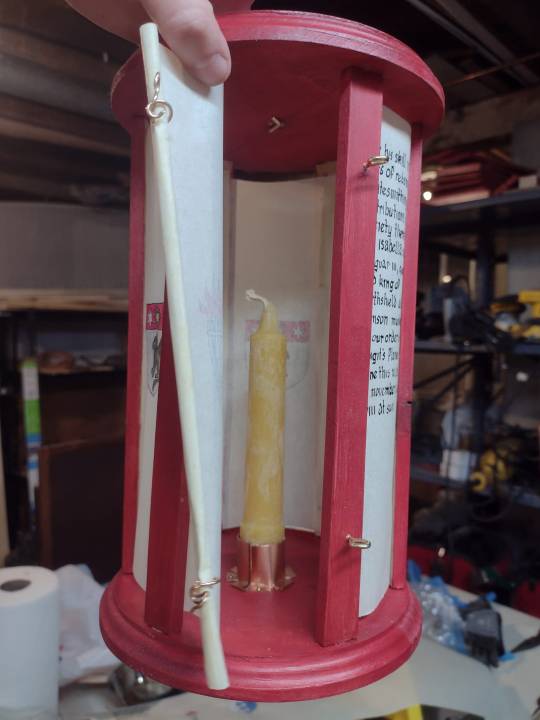
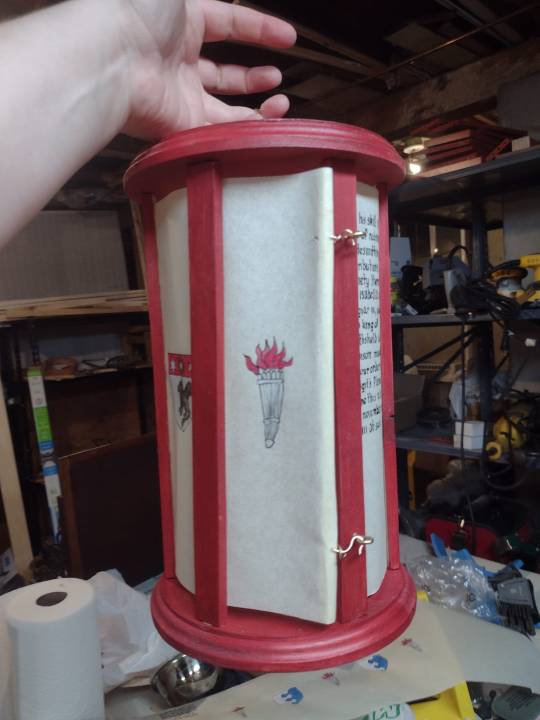
Here is the final assembly completed, showing the door hooks made of bronze and the eyelet screws made of brass. This is not a very historic door shape, but it's what Morgan Donner hacked together for her lanterns and if it worked for her it'll work for me.

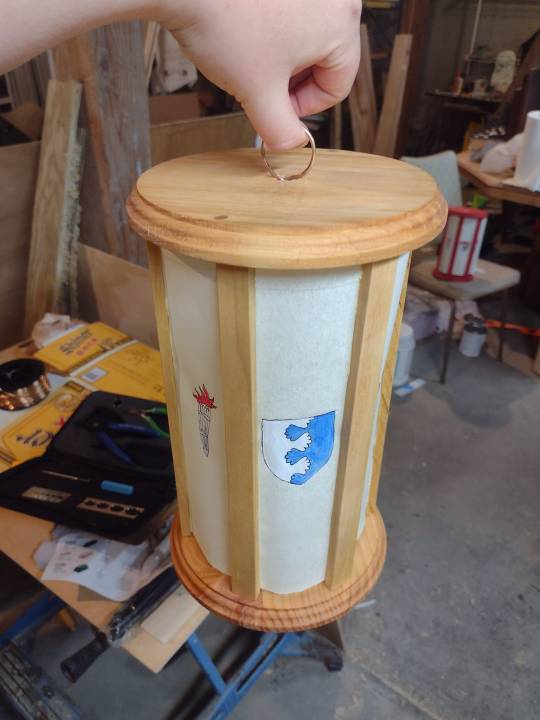
Kat's scroll completed as well, and here's the only view I have of the top suspension ring.


And of course it's not a lantern if you don't see it illuminated. I gave both recipients a beeswax candle and an electric candle, and this photo was taken with the electric candle in place. I had to wrap gaffer tape around the base to make it fit. The electric candle is actually pretty bright! Look at that pretty red paint, and not the fact that the support is slightly angled.
42 notes
·
View notes
Text
Demands for a federal investigation mount as witnesses and survivors of a gangway collapse at a dock in Georgia describe the “catastrophic failure” that killed seven people traveling for a festival celebrating Gullah Geechee history. At a news conference Tuesday morning, Regina Brinson described being on the dock when she heard a crack. She was with several people who were trying to board the final ferry to Sapelo Island on Saturday. Brinson said she turned around to see the metal walkway crumple, plummeting her and several other people into the water beneath the ferry dock, including her uncle, Isaiah Thomas, 79. Brinson held on to the side of the structure as Thomas grabbed her hand and clothes, pulling her head underwater. “I had to take his fingers, one by one, and peel them off of my shirt,” Brinson said while sobbing. “And I pulled him back up to the top, and I saw his face. And I was like, ‘Oh, my God, what did I do? What did I do?’ And he floated by me.” Katrena Alexander added that she barely avoided being plunged into the water. “There were just a few people behind us when we heard all the screaming and going on and so I turned around, and when I turned around, I couldn’t believe what I saw, and I was just shocked. I just couldn’t say nothing,” she said through tears. All of the people who died from the collapse were 73 and older. They were Jacqueline Crews Carter, 75, of Jacksonville, Florida; Cynthia Gibbs, 74, of Jacksonville; Charles L. Houston, 77, of Darien, Georgia; William Johnson Jr., 73, of Atlanta; Carlotta McIntosh, 93, of Jacksonville; Thomas, of Jacksonville; and Queen Welch, 76, of Atlanta.
6 notes
·
View notes
Video
youtube
McIntosh County Shouters: Gullah-Geechee Ring Shout from Georgia
The McIntosh County Shouters is a ten-member Gullah-Geechee group that began performing professionally in 1980. They have educated and entertained audiences around the United States with the "ring shout," a compelling fusion of counterclockwise dance-like movement, call-and-response singing, and percussion consisting of hand claps and a stick beating the rhythm on a wooden floor.
African in its origins, the ring shout affirms oneness with the Spirit and ancestors as well as community cohesiveness. The ring shout was first described in detail during the Civil War by outside observers in coastal regions of South Carolina and Georgia. Its practice continued well into the 20th Century, even as its influence was resounding in later forms like spiritual, jubilee, gospel and jazz.
By the late 20th century, the ring shout itself was presumed to have died out until its rediscovery in McIntosh County in 1980; thus, the beginning of the McIntosh County Shouters.
The group was awarded the NEA National Heritage Fellowship in 1993, and were selected as Producers of Distinction and Founding Members of the "Georgia Made Georgia Grown Program," in 2009.
Their performances include the National Black Arts Festival, of Smithsonian Folklife Festival, World Music Institute, and Sound Legacies at Emory University. The group has been featured in magazines and documentaries, including HBO's Unchained Memories.
#gullah Geechie#georgia sea islands#Black History Matters#Gullah History Matters#Ring Shouters#evangelicals#call and response#McIntosh County Shouters: Gullah-Geechee Ring Shout from Georgia
38 notes
·
View notes
Text
Dock walkway collapse kills 7 in U.S. state of Georgia
Sapelo Island, where the Gullah-Geechee community held a festival to celebrate, on June 10, 2013. File | Photo Credit: AP “A dock walkway collapse killed seven people in the southern U.S. state of Georgia on Saturday Saturday (October 20, 2024),” authorities said, as crowds gathered for a festival on an island. At least 20 people were tossed into the waters off Sapelo Island and an unknown…

View On WordPress
0 notes
Text
The Darker Side of Charleston's History: Slavery and Its Legacy Shop Local Charleston, SC Businesses [ad_1] Charleston, South Carolina is a city steeped in history, from its cobblestone streets to its picturesque antebellum architecture. However, behind the charming facade lies a darker side of the city's past - a legacy of slavery that has left a lasting impact on Charleston and its residents. The Legacy of Slavery Charleston was once one of the largest slave trading ports in the United States, with thousands of enslaved Africans passing through its docks on their way to plantations in the South. The city's economy was built on the backs of enslaved people, who toiled in the fields and homes of the wealthy white elite. Today, reminders of Charleston's slaveholding past can be found throughout the city. Historic plantations such as Boone Hall and Magnolia Gardens offer tours that highlight the lives of enslaved people who once worked on these estates. The Old Slave Mart Museum, located in downtown Charleston, tells the story of the city's role in the slave trade and the impact it had on the lives of African Americans. The Gullah Geechee Culture One of the lasting legacies of slavery in Charleston is the Gullah Geechee culture, a distinct African-American culture that has survived in the Lowcountry for centuries. The Gullah Geechee people are descendants of enslaved Africans who were brought to the South Carolina coast to work on rice plantations. The Gullah Geechee culture is characterized by its unique language, cuisine, music, and art. Visitors to Charleston can experience Gullah Geechee culture firsthand by attending one of the many cultural festivals held throughout the year or visiting the historic sites where Gullah Geechee traditions are still practiced. Preserving Charleston's History While the legacy of slavery in Charleston is a painful part of the city's past, efforts are being made to preserve this history and educate visitors about its impact. The International African American Museum, set to open in Charleston in 2022, will tell the story of African Americans in the Lowcountry, from slavery to the present day. Additionally, the Gullah Geechee Cultural Heritage Corridor, a National Heritage Area that spans four states along the Atlantic coast, works to preserve and promote Gullah Geechee culture and history. Visitors to Charleston can learn about the Gullah Geechee people and their contributions to the city's rich cultural tapestry. Conclusion Charleston's history is complex and multi-faceted, with a legacy of slavery that continues to shape the city and its residents. By exploring the darker side of Charleston's past, visitors can gain a deeper understanding of the city's history and the impact of slavery on its culture and heritage. Through efforts to preserve and promote the stories of enslaved people and the Gullah Geechee culture, Charleston is working to ensure that this important part of its history is not forgotten. By acknowledging the darker side of its past, Charleston is taking steps to confront its history and move toward a more inclusive and equitable future. Visitors to Charleston are encouraged to explore the city's historic sites, museums, and cultural events to learn more about its complex and fascinating history. By engaging with the darker side of Charleston's past, visitors can gain a deeper appreciation for the rich tapestry of stories that make up this vibrant and historic city. [ad_2] LEARN MORE: History of Charleston SC Best: Places to eat in Charleston SC FIND: Things to do in Charleston SC CHARLESTON BUSINESS OWNERS: Get a Free Business Profile FIND BUSINESSES: Charleston Business Directory BE SEEN: Advertise Your Business Here #HISTORY
0 notes
Text
The Darker Side of Charleston's History: Slavery and Its Legacy Shop Local Charleston, SC Businesses [ad_1] Charleston, South Carolina is a city steeped in history, from its cobblestone streets to its picturesque antebellum architecture. However, behind the charming facade lies a darker side of the city's past - a legacy of slavery that has left a lasting impact on Charleston and its residents. The Legacy of Slavery Charleston was once one of the largest slave trading ports in the United States, with thousands of enslaved Africans passing through its docks on their way to plantations in the South. The city's economy was built on the backs of enslaved people, who toiled in the fields and homes of the wealthy white elite. Today, reminders of Charleston's slaveholding past can be found throughout the city. Historic plantations such as Boone Hall and Magnolia Gardens offer tours that highlight the lives of enslaved people who once worked on these estates. The Old Slave Mart Museum, located in downtown Charleston, tells the story of the city's role in the slave trade and the impact it had on the lives of African Americans. The Gullah Geechee Culture One of the lasting legacies of slavery in Charleston is the Gullah Geechee culture, a distinct African-American culture that has survived in the Lowcountry for centuries. The Gullah Geechee people are descendants of enslaved Africans who were brought to the South Carolina coast to work on rice plantations. The Gullah Geechee culture is characterized by its unique language, cuisine, music, and art. Visitors to Charleston can experience Gullah Geechee culture firsthand by attending one of the many cultural festivals held throughout the year or visiting the historic sites where Gullah Geechee traditions are still practiced. Preserving Charleston's History While the legacy of slavery in Charleston is a painful part of the city's past, efforts are being made to preserve this history and educate visitors about its impact. The International African American Museum, set to open in Charleston in 2022, will tell the story of African Americans in the Lowcountry, from slavery to the present day. Additionally, the Gullah Geechee Cultural Heritage Corridor, a National Heritage Area that spans four states along the Atlantic coast, works to preserve and promote Gullah Geechee culture and history. Visitors to Charleston can learn about the Gullah Geechee people and their contributions to the city's rich cultural tapestry. Conclusion Charleston's history is complex and multi-faceted, with a legacy of slavery that continues to shape the city and its residents. By exploring the darker side of Charleston's past, visitors can gain a deeper understanding of the city's history and the impact of slavery on its culture and heritage. Through efforts to preserve and promote the stories of enslaved people and the Gullah Geechee culture, Charleston is working to ensure that this important part of its history is not forgotten. By acknowledging the darker side of its past, Charleston is taking steps to confront its history and move toward a more inclusive and equitable future. Visitors to Charleston are encouraged to explore the city's historic sites, museums, and cultural events to learn more about its complex and fascinating history. By engaging with the darker side of Charleston's past, visitors can gain a deeper appreciation for the rich tapestry of stories that make up this vibrant and historic city. [ad_2] LEARN MORE: History of Charleston SC Best: Places to eat in Charleston SC FIND: Things to do in Charleston SC CHARLESTON BUSINESS OWNERS: Get a Free Business Profile FIND BUSINESSES: Charleston Business Directory BE SEEN: Advertise Your Business Here #HISTORY
0 notes
Text
Georgia Roots Nurturing a Tapestry of History Culture and Diversity
Georgia, nestled in the southeastern United States, is a state rich in history, culture, and diversity. From its picturesque landscapes to its vibrant cities, Georgia's roots run deep, weaving a tapestry that reflects the resilience and interconnectedness of its people.

The historical narrative of Georgia is a captivating journey that spans centuries. Founded in 1732 as the last of the original thirteen colonies, Georgia played a pivotal role in the American Revolution and later became a vital player in the Civil War. The state's rich history is palpable in its antebellum architecture, with cities like Savannah boasting cobblestone streets and well-preserved mansions that transport visitors back in time.
Central to Georgia's identity is its role in the Civil Rights Movement of the 20th century. Atlanta, the state's capital, was a key hub for civil rights activities led by prominent figures such as Martin Luther King Jr. and John Lewis. The city's historic sites, including the Martin Luther King Jr. National Historic Site, serve as reminders of the courageous individuals who fought for equality and justice.
Georgia's cultural diversity is reflected in its people, music, and cuisine. The state is home to a melting pot of ethnicities, from the Gullah-Geechee communities along the coast to the vibrant Hispanic and Asian communities in the urban centers. This diversity is celebrated in various festivals and events that showcase the unique traditions and customs of Georgia's residents.
Music pulses through the veins of Georgia, contributing to its cultural vibrancy. Atlanta, often referred to as the "Hip-Hop Capital of the South," has been a breeding ground for influential artists in various genres, from country and blues to hip-hop and R&B. The state's musical heritage is on display in the iconic Georgia Music Hall of Fame, honoring legendary musicians who have shaped the industry.
Georgia's natural beauty is equally enchanting, with landscapes ranging from the mist-covered Blue Ridge Mountains to the scenic marshes of the Golden Isles. The state's commitment to conservation is evident in its numerous national parks, such as the Chattahoochee River National Recreation Area and the Okefenokee Swamp, providing habitats for diverse flora and fauna.
Agriculture is deeply ingrained in Georgia's roots, with the state being a major contributor to the nation's farm output. The peach, often synonymous with Georgia, is a symbol of the state's agricultural prowess, and the annual Georgia Peach Festival pays homage to this succulent fruit. Beyond peaches, Georgia is a leading producer of peanuts, pecans, and Vidalia onions, showcasing the state's agricultural diversity.
Georgia's commitment to education is evident in its renowned institutions, including the University of Georgia, Georgia Institute of Technology, and Emory University. These educational hubs contribute to the state's intellectual vibrancy and attract students from across the globe, fostering innovation and research.
Georgia's roots run deep, intertwining a fascinating tapestry of history, culture, and diversity. From its pivotal role in shaping the nation's history to its vibrant present-day communities, Georgia continues to evolve while remaining firmly connected to its rich heritage. Whether exploring historic sites, savoring its diverse cuisine, or immersing oneself in the arts, Georgia invites visitors and residents alike to embrace the multifaceted layers of its identity. As the state continues to grow and thrive, its roots remain a source of inspiration, grounding it in a legacy that is as enduring as the southern soil itself.
For more info:-
Georgia Roots
Georgia Roots Outdoor Living
0 notes
Photo




in the anointed land of the Gullah Geechee people for Famlee Festival 2022 flowing with the rhythm of the spirits of my yeye, Queen Quet, and the guardians of the land. dance draws out the essence of all that came before me. for this, I am eternally grateful.
9 notes
·
View notes
Text
Black-eyed peas, are native to West Africa, and are prevalent in cuisines throughout that region. They belong to a variety of beans called either “cowpeas” on the continent or “field peas” in the south. Cowpeas were often served on festive occasions such as the birth of a child, a funeral, or a homecoming. They are are considered a good luck charm that helps to ward off the evil eye.
.
.
.
.
Just like so many of our dietary staples, our ancestors, carried this bean from the continent, and by the mid 1700s, it was documented as being eaten in the Americas on a regular basis. And just like on the continent, it continued to be a regular on the menu when it came to celebrations such as New Year.
.
.
.
.
Over the years, the tradition has evolved and changed in different regions. In Geechee Gullah cultures, they are served with rice, and a dime is placed in the bottom of the pot to symbolize the beans bringing prosperity to the new phase. If you got the dime in your serving, you got an extra helping of good luck. As the celebration evolved, leafy greens were added to the mix to symbolize the prosperity of folding money (dollar bills).
.
.
.
.
As you eat your black eyed peas and greens tonight and tomorrow - think about this meal as the embodiment of our peoples ingenuity. Many Hoodoo traditions are the passing on of African traditions. Keep them close. Honor them. Hold on to them.
���🔮🎴

14 notes
·
View notes
Text
Gullah Geechee Culture and History Discussed at Cultural Heritage Festival of Learning
Wilmington, NC (February 6, 2019)
Community members and scholars came together in January for the Gullah Geechee Cultural Heritage Festival of Learning, held at the University of North Carolina in Wilmington, NC, on January 25-26, 2019. Members of the Gullah Geechee Cultural Historical Commission, which manages the Gullah Geechee Cultural Heritage Corridor, participated in panels and facilitated discussions about Gullah Geechee culture and language during the two-day forum.

Painting by Cassandra M. Gillins at the festival’s art exhibit. The painting shows a family with arms interlocked on a pier: three children, a woman, a man, and a dog. (Image courtesy of the Gullah Geechee Cultural Heritage Commission.)
The Gullah Geechee Cultural Heritage Corridor covers a 400-mile stretch of the coastal area from Florida to North Carolina. Beginning in the 17th century, Africans from different ethnic and social groups were taken from their homelands and enslaved on rice plantations on sea islands and barrier islands along the coast. Over time, these people and their descendants developed a unique language and preserved many African traditions and practices that resulted in the Gullah Geechee culture that is still vibrant today.
Panels at this year’s Festival of Learning covered Gullah Geechee language, music, preservation of heritage sites, obstacles to cultural preservation, and the history of slavery. Gullah Geechee community members also presented their own oral histories, and two documentaries were screened: The Language You Cry In (1998) and Family Across the Sea (1991). In between sessions, attendees were able to enjoy a Gullah art exhibit sponsored by the Wilmington Arts Council.

Photo of woman holding a large black-and-white photo of a seated man during an oral history presentation at the festival. (Photo credit: Gullah Geechee Cultural Heritage Commission.)
The Gullah Geechee Cultural Heritage Corridor has a great line up of events for 2019. To find out more, visit the Gullah Geechee Cultural Heritage Corridor website.
2 notes
·
View notes
Text
Tragedy Strikes Sapelo Island Festival: Community Mourns Loss
A Tragic Day on Sapelo Island On a beautiful day at Sapelo Island, nestled just off the enchanting curve of the Georgia coast, a community gathered to celebrate resilience—a tribute to a people and a culture that has endured fragility for generations without ever being broken. The air was filled with the enticing aroma of smoked mullet, while vendors offered delicious plates of red peas and rice.…
#community#dock collapse#festival#Georgia coast#Gullah Geechee#heritage#investigation#resilience#Sapelo Island#tragedy
0 notes
Text
What are the Some Fun Things to Do in Charleston?
Established in 1670, Charleston, the South Carolina port city is characterized by its cobblestone avenues, horse-drawn carriages, and pastel antebellum houses, specifically in the elegant French Quarter and Battery districts. If you are looking for a place in the USA to spend your vacation, this destination will turn into an incredible choice.
This place has so much to offer that you will find it almost magical. Whether you love beaches or shopping centers, this place almost has something to offer to every traveller. This place exemplifies the romantic idea of the Old South, with its aristocratic homes surrounded by dense vegetation, and atmospheric brick lanes.
In 1773, Charleston was defined as the most affluent town in the American South, and today, it maintains perhaps more than any other, the ambiance of plantation community.
Undoubtedly, fall and spring make the finest times to explore Charleston because of its pleasant weather and a comprehensive array of seasonal events, you will still discover noteworthy experiences during the month of July. Fun things to do in Charleston in the month of July are mentioned below:
· The Charleston Farmers Market: At this farmers market at Marion Square in downtown Charleston, you will discover numerous food and fresh produce stalls, and arts and crafts shopkeepers. It’s accessible every Saturday from 8 a.m. to 2 p.m. and operates from early April to late November.

· Charleston Caribbean Jerk Festival: This annual event at Riverfront Park in North Charleston incorporates scrumptious Caribbean food and lively music. The festival is July 16; tickets are needed (for a fee) and can be purchased with just a click. If you love to eat Caribbean food or adore good music, this festival will impress you.
· Sweetgrass Cultural Arts Festival: An individual can attend this festival on July 23 to commemorate all things Gullah Geechee culture and shop locally made crafts, such as sweetgrass baskets and jewellery. The jewellery that you will find here will surely evoke the fashionista for you. You can also buy them as a souvenir.
· Music on the Green: You can enjoy this free, family-friendly outdoor concert series on every Friday through August. It incorporates a vast range of music genres. The events are organized at Freshfields Village, about 20 miles southwest of the Charleston city center.
When it comes to one of the Best Places to Visit in Charleston, you can’t ignore Waterfront Park. Here tourists and locals come to unwind and admire the spectacular views of Charleston Harbour.
There are so many Best Places to Visit in Charleston, but the above-written events will make your vacation to the place more special.
1 note
·
View note
Text
Gullah people
The Gullah Geechee people live along the Carolinas/Georgia/Florida coasts. (Gullah is sometimes reserved for those along the Carolinas coast, Geechee for those along the Georgia/Florida coast) They are descendants of enslaved peoples from west Africa. They have a distinctive dialect, music, food, arts/crafts and so on. I first learned about them through the Newport Folk Festival’s Georgia Sea…

View On WordPress
1 note
·
View note
Photo

Virtual Field Trip ~ Celebrating Black History Month
Since 1976, every American President has designated February as Black History Month and endorsed a specific theme. The Black History Month theme for 2021, “Black Family: Representation, Identity and Diversity,” explores the African diaspora and the spread of Black families across the United States. On February 3, 2021 at 8 p.m., The Museum of Food and Drink and the Smithsonian Folklife Festival host Migration Stories: Sustaining Gullah Geechee Cooking Across Land and Sea, a virtual event that explores the foodways and cultural heritage of the Gullah Geechee people. The first in a series, the migration, food and the transmission of knowledge in America will be explored. Participants can also cook along chef Amethyst Ganaway in her cooking demonstration of Carolina crab rice. The National Museum of American History explores key social studies topics featuring museum resources from the Smithsonian in Smithsonian Social Studies Online: Black History Month. This episode focuses on Black History Month and will be held on February 4, 2021 at 11 a.m. Additional information including Social Studies Online resources and episodes can be found at learninglab.si.edu. Students in third to eighth grade learning from home are invited to Boston's Museum of Fine Arts livestream program to explore paintings by 20th-century Black artists selected by Boston teens. A museum curator guides the discussion, and students will also learn how their peers curated the exhibition. The event will be held on February 8, 2021 at 11:10 a.m. or 1:10 p.m. Joyful Fridays welcomes children every Friday in February to create art that celebrates Black joy, history and culture. The program is inspired by the museum’s Joyful ABC’s activity book series which features activities, museum objects and new words based on characteristics featured in the book, A is for All the Things You Are: A Joyful ABC Book. 🗺Colonial Capital Tours ☎️ 800.334.3754 💻 www.ColonialCapitalTours.com 📧 [email protected] #studenttours #schooltrips #grouptours #educationaltours #fieldtrips #daytrips #onedaytrips #studentgroups #schoolgroups #educationalstudenttours #nycdoevendor #seniortrips #multidaytrips #studenttrips #educationalprograms #virtualexhibits #virtualevents #vritualfieldtrips #virtualprograms #onlineexhibits #onlineprograms #onlineevents #blackhistorymonth #blackhistorymonth2021 #americanhistory #history #february2021 #colonialcapitaltours @colonialcapitaltours
0 notes
Photo

Just realized that the Gullah/Geechee Gold Rice Festival, The Cooper River Bridge Run, and the Grits Festival are all Saturday. The trip to Edisto is gonna be so much fun.
1 note
·
View note